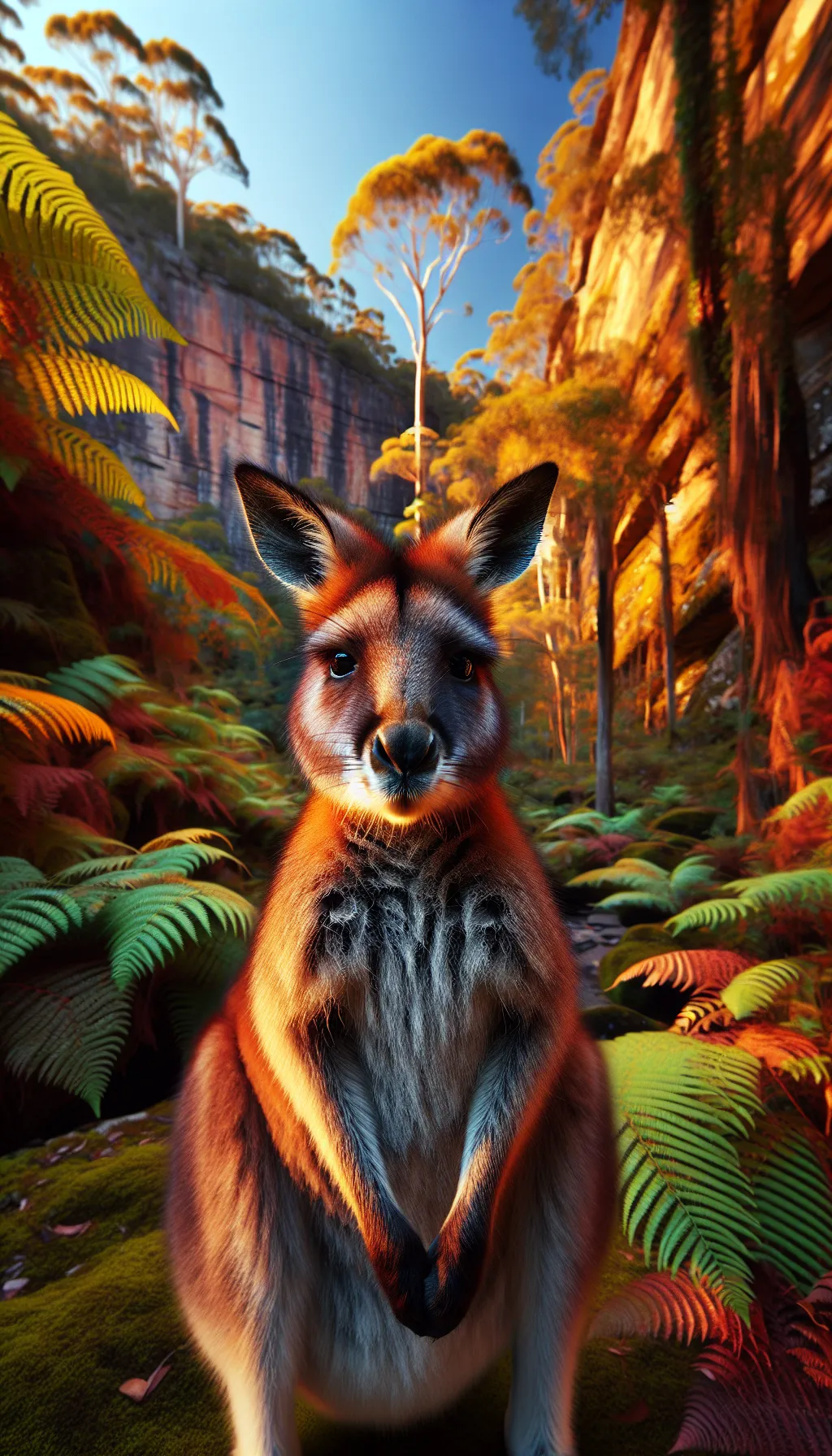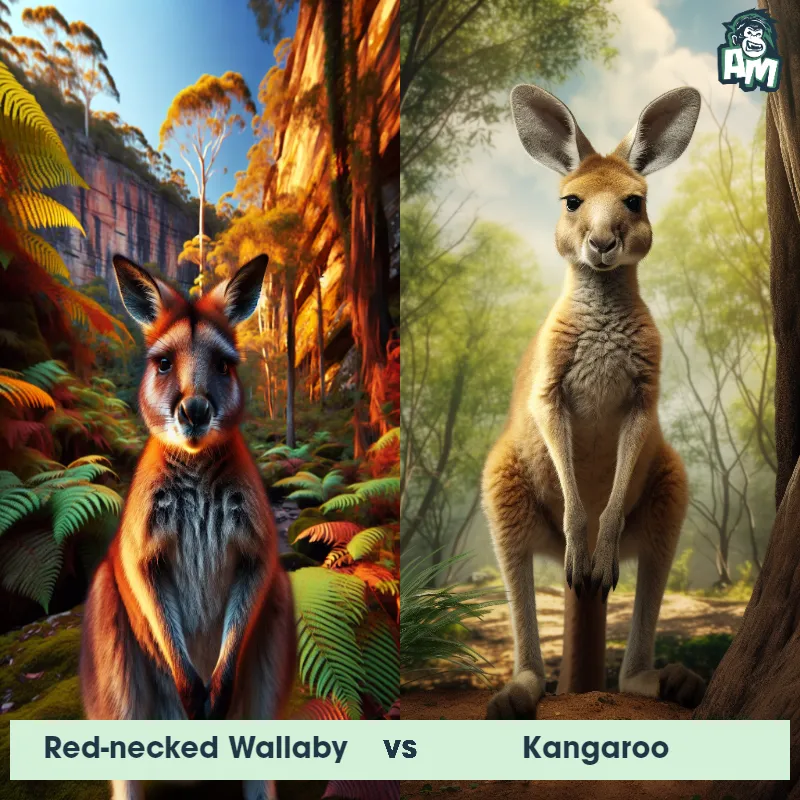The Red-Necked Wallaby
The Red-Necked Wallaby, also known as Macropus rufogriseus, is a medium-sized marsupial native to the eastern regions of mainland Australia, as well as Tasmania. This wallaby species is known for its reddish-brown fur on its neck and shoulders, which contrasts with its gray-brown fur on the rest of its body. It has powerful hind legs that allow for swift and agile movements, while its long tail provides balance and stability. Red-Necked Wallabies mainly feed on grasses, shrubs, and leaves, and they can often be found in open woodlands or grassy areas.

| Red-Necked Wallaby | |
|---|---|
| Size | 2-3 feet (0.6-0.9 meters) |
| Weight | 20-40 pounds (9-18 kilograms) |
| Speed | 30mph (48km/h) |
| Key Strength | Agility and powerful hind legs for kicking |
| Biggest Weakness | Limited upper body strength |
| Scientific Name | Macropus rufogriseus |
| Family | Macropodidae |
| Habitat | Forests, woodlands, coastal heath, and sub-alpine regions |
| Geography | Endemic to Australia |
| Diet | Grasses and shrubs |
| Lifespan | 10 years - 15 years |

The Red-Necked Wallaby
The Red-Necked Wallaby, also known as Macropus rufogriseus, is a medium-sized marsupial native to the eastern regions of mainland Australia, as well as Tasmania. This wallaby species is known for its reddish-brown fur on its neck and shoulders, which contrasts with its gray-brown fur on the rest of its body. It has powerful hind legs that allow for swift and agile movements, while its long tail provides balance and stability. Red-Necked Wallabies mainly feed on grasses, shrubs, and leaves, and they can often be found in open woodlands or grassy areas.
Fun Fact: The Red-Necked Wallaby is a highly adaptable species that can thrive in various environments, from coastal regions to mountainous areas, as long as there is sufficient vegetation and access to water.
| Red-Necked Wallaby | |
|---|---|
| Size | 2-3 feet (0.6-0.9 meters) |
| Weight | 20-40 pounds (9-18 kilograms) |
| Speed | 30mph (48km/h) |
| Key Strength | Agility and powerful hind legs for kicking |
| Biggest Weakness | Limited upper body strength |
| Scientific Name | Macropus rufogriseus |
| Family | Macropodidae |
| Habitat | Forests, woodlands, coastal heath, and sub-alpine regions |
| Geography | Endemic to Australia |
| Diet | Grasses and shrubs |
| Lifespan | 10 years - 15 years |
Red-Necked Wallaby Matchups
We use AI to simulate matchups between the Red-Necked Wallaby and other animals. Our simulation considers size, strength, and natural predatory behaviors to determine the most likely outcome.

Can't find the Matchup you want?
Create Your Own MatchupRed-Necked Wallaby: Diet, Predators, Aggression, and Defensive Behaviors
What do Red-Necked Wallabies eat?
Red-Necked Wallabies are herbivores and primarily feed on a variety of grasses, herbs, leaves, and shrubs. They are known to graze in open grasslands during the early mornings and late afternoons. Additionally, they may also consume fruits and vegetables if available.
Do Red-Necked Wallabies have any predators?
Red-Necked Wallabies have predators such as dingoes, foxes, eagles, and Tasmanian devils. Juvenile wallabies are particularly vulnerable to predation due to their smaller size and lack of experience in avoiding predators.
Are Red-Necked Wallabies aggressive?
Red-Necked Wallabies are generally peaceful and docile animals. However, they may exhibit aggressive behavior towards one another during mating season or when competing for resources such as food or territory. This aggression is typically displayed through boxing with their powerful hind legs.
Do Red-Necked Wallabies fight?
Red-Necked Wallabies may engage in fights with other wallabies, particularly males during mating season. These fights involve boxing with their hind legs and can be quite intense as they compete for mating opportunities and establish dominance within their social hierarchy.
How do Red-Necked Wallabies defend themselves?
Red-Necked Wallabies primarily defend themselves by using their powerful hind legs to kick potential threats. They are known to deliver swift and forceful kicks to ward off predators or rivals. In addition to kicking, they may also use their agility and speed to escape from danger.
What is the Red-Necked Wallabies' biggest weakness in a fight?
The Red-Necked Wallabies' biggest weakness in a fight is their relatively small size compared to some of their predators. While they are agile and can deliver powerful kicks, they can be overpowered by larger predators such as dingoes or Tasmanian devils. In such situations, their best defense is often to flee and seek refuge in dense vegetation.
Fun Fact: Unlike most other wallaby species, Red-Necked Wallabies are primarily solitary animals, only coming together to breed or during periods of extreme weather conditions.
Fun Fact: Male Red-Necked Wallabies are capable of performing impressive display behaviors, such as "boxing." During this behavior, they stand on their hind legs and strike their opponents with their powerful forelimbs, using their tail for balance, as a means of asserting dominance or resolving conflicts.











